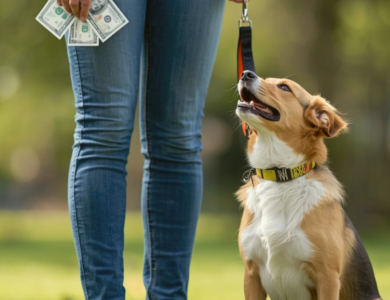We may earn a commission when you click on links across our website. This does not influence our opinions — learn more.
Canine Hip Displaysia: What Does It Mean?

Hip dysplasia is an all-too-common health issue in dogs, especially in larger breeds, and it can affect their ability to move comfortably. Our team’s pup: Roadie, who is an adopted mix-breed, has shown early signs of hip challenges. With early detection and the right care, many dogs can still live happy, active lives. If you’ve noticed your dog is struggling to jump or move around as easily as before, or if you’re considering adopting a dog or purchasing a breed at risk, it’s worth understanding what hip dysplasia is, how it’s diagnosed, and what can be done to help your dog feel better.
What Is Hip Dysplasia in Dogs?
Hip dysplasia happens when the hip joint doesn’t develop as it should. Normally, the ball at the top of the thigh bone (the femur) fits snugly into the hip socket. In dogs with hip dysplasia, this ball-and-socket joint isn’t as well-formed, causing instability. Over time, this can lead to arthritis and significant pain in the joint.
While genetics are the main culprit, environmental factors like rapid growth (especially in puppies) and obesity can make the condition worse. It’s not just something that happens in older dogs; it can develop in puppies, too, particularly if they’re growing too quickly.
Which Dogs Are Most at Risk?
Certain breeds are more likely to develop hip dysplasia, especially large and giant breeds. Some of the most affected breeds include Labrador Retrievers, Golden Retrievers, German Shepherds, Rottweilers, Great Danes and Saint Bernards.
But it’s important to know that smaller breeds can get hip dysplasia, too, Cavalier King Charles Spaniels and French Bulldogs are examples of littles that may be impacted. So even if you’re not raising a giant dog, it’s still good to be aware of this condition.
How Do I Know If My Dog Has Hip Dysplasia?
Dogs with hip dysplasia often show signs like those below:
- Struggling to rise or jump: If your dog seems reluctant to get up after lying down or has trouble jumping onto the couch or into the car, that could be a sign.
- Limping or stiffness: Look out for any limping, especially after exercise, or stiffness in the back legs.
- Bunny hopping: Dogs with hip dysplasia often hop like a rabbit when running, instead of using a natural stride.
- Reduced activity: If your dog is slowing down and avoiding walks or playtime, it might be because of pain or discomfort.
If you notice any of these signs, it may be a good idea to check in with your vet for a closer look.
How Is Hip Dysplasia Diagnosed?
To diagnose hip dysplasia, your vet will likely start with a physical exam and may do a test called the Ortolani sign, where they gently move the dog’s legs to see if the hip joint is loose.
The most definitive way to diagnose hip dysplasia, however, is said to be through X-rays. These give a clear picture of how the hip joints are structured and whether there’s any evidence of arthritis or instability. For X-rays to be accurate, the dog typically needs to be at least 16 weeks old at a minimum. Before this age, the hip joints can still be too flexible to provide reliable reading. As dogs do continue to grow, some veterinarians advise true results can’t be seen until the dog is over two.
Some veterinary clinics also offer specialized screenings like PennHIP and OFA (Orthopedic Foundation for Animals) tests, which can give a more detailed analysis of the hip joint.
What Are the Treatment Options?
The treatment you choose for your dog will depend on the severity of the hip dysplasia and your dog’s age, health and care plan.
Non-Surgical Options
If your dog has mild hip dysplasia or if surgery isn’t an option, there are still plenty of ways to help manage the condition and make your dog more comfortable:
- Weight management: Keeping your dog at a healthy weight is crucial, as extra pounds put more pressure on the joints.
- Exercise: Low-impact activities like swimming and short walks are great for keeping your dog active without over-stressing the joints.
- Pain relief: Nonsteroidal anti-inflammatory drugs (NSAIDs) can help reduce pain and swelling but only give these under your vet’s guidance.
- Joint supplements: Some owners find that supplements like glucosamine and chondroitin help support joint health.
- Physical therapy: Massage, acupuncture, and hydrotherapy can be excellent for improving mobility and reducing discomfort.
Surgical Options
For dogs with severe hip dysplasia or those that aren’t responding well to conservative treatments, surgery might be the best option. Surgical treatments include:
- Juvenile Pubic Symphysiodesis (JPS): This is a preventive procedure performed in puppies younger than 20 weeks. It helps correct the hip joint alignment early, preventing further problems as the dog grows.
- Triple Pelvic Osteotomy (TPO): This surgery repositions the hip socket in younger dogs without severe arthritis.
- Femoral Head Ostectomy (FHO): In this procedure, the head of the femur is removed to eliminate pain, which is generally used for small and medium-sized dogs.
- Total Hip Replacement (THR): In severe cases, THR can be done to replace the damaged hip joint with an artificial one, offering significant pain relief and improved mobility.
What’s the Long-Term Outlook?
If your dog is diagnosed with hip dysplasia, the future doesn’t have to be bleak. With proper management, many dogs go on to live active, happy lives. While some will need ongoing care (especially if surgery is required), early diagnosis and treatment often lead to good outcomes. For dogs that undergo surgery like a total hip replacement, they can often resume normal activities, including running and jumping.
How Common Is Hip Dysplasia?
Hip dysplasia is a widespread condition, especially in larger dog breeds. In fact, studies suggest that about 20% of dogs in the U.S. are affected to some degree, though the prevalence can be much higher in large breeds. The good news is that screening programs and responsible breeding practices are helping to reduce the incidence of hip dysplasia over time.
Can I Prevent Hip Dysplasia?
While hip dysplasia is largely genetic, there are a few things you can do to reduce the risk:
- Do not purchase your dog from Puppy Stores: Make sure your dog’s breeder conducts health screenings for hip dysplasia and other genetic conditions before breeding.
- Control your dog’s weight: Preventing obesity is crucial because extra weight can put unnecessary stress on the joints.
- Feed a balanced diet: Make sure your puppy gets the right nutrients for healthy bone development, and avoid overfeeding, which can lead to rapid growth.
- Exercise appropriately: Don’t overdo it on high-impact activities when your dog is young. Gentle play and controlled walks are best for growing puppies.
Hip dysplasia can be a worrying diagnosis for dog owners, but it’s not the end of the road, nor should it stop you from adopting pups of any breed. With the right care, treatment, and lifestyle adjustments, many dogs with hip dysplasia can continue to live an active, fulfilling life. If you’re concerned about your dog’s mobility, or if you’re adopting a breed prone to this condition, early diagnosis and intervention are key to managing the disease and improving your dog’s quality of life.
For more information, we recommend you reach out to your vet and read further from reputable resources like the Cornell University College of Veterinary Medicine, or the Orthopedic Foundation for Animals.



